Gun violence is the number one issue plaguing the city in this moment.
— Mayor Lori Lightfoot, July 15, 20211
There can be no question that the great increase in juvenile crime has been accompanied by a similar increase in the possession of guns.
— Mayor Richard J. Daley, November 30, 19662
Introduction
From May 29, 2020, onward, the City of Chicago witnessed an escalating wave of protests against police violence under the Black Lives Matter (BLM) banner.3 On one count, some 52,000 people participated in BLM protests in the city.4 Many hoped that such mobilization “would democratize our politics and embolden our visions for change,”5 especially when it came to public safety.6 Yet just over a year later, the Chicago City Council passed Mayor Lori Lightfoot’s municipal budget with a $189 million dollar jump in police funding.7 That budget received support from several Democratic Socialist alderpeople8 — previously among BLM’s most vociferous supporters9 — and many progressive activists.10 No law forced the council’s or the mayor’s hands. Unlike many other jurisdictions, Chicago does not have a “structural entrenchment” of law enforcement arising from an “insulation of urban police departments” through state legislation.11 To the contrary, earlier in 2021, Governor Jay Pritzker had signed a “sweeping” criminal justice reform bill partly in response to concerns about racial justice.12 State-level forces, that is, listed in favor of change. What then happened to defuse the momentum of social change in Chicago?
The answer, we contend in this Essay, has in part to do with guns, and in particular the way that we talk about guns. Through increased rhetoric about illegal guns and heightened enforcement of gun possession laws, Chicago’s mayor and police chief have managed to legitimize an increase in policing that widened racial inequalities at a time of unprecedented pressure from activists. In the teeth of sharp criticism from BLM, Mayor Lightfoot deployed a historically enduring set of arguments about gun violence against liberal, reform-minded political competitors. At the same time, her police superintendent pressed for a set of coercive responses that again had at best questionable effects on gun violence even as they more assuredly reinforced racially stratified patterns of law enforcement. The result has been a shift in policing resources that has increased the disparate burden of policing upon Chicago’s Black and Hispanic communities without much evidence of an offsetting public-safety benefit. This echoes experience in similar past periods of social unrest, when Chicago used gun talk to defuse mobilizing energies of social movements. In 2020, as before, officials tendered both regulatory and coercive interventions in response to the perceived problem of gun violence. The former have tended to wither; the latter endure, even if their effect upon actual rates of gun-related crimes is ambiguous at best.
The political discourse of gun crime, to be clear, is only one strand in a larger network of reactionary forces pushing against the changes pressed by BLM and its allies. Across the country, the share of general funds devoted by large cities to policing fell less than one percent between 2020 and 2021.13 Three states — Florida, Georgia, and Texas — have enacted new statutory constraints on municipal reallocation of funds away from police.14 Our aim here is to draw attention to just one strategy for countering reform. The latter is endogenous to municipal politics, but can be discerned even in a relatively progressive city in a progressive state. We offer a detailed accounting of this strategy’s history, mechanisms, and effects. While we do not claim here that our account can be generalized beyond Chicago — our research on this score is ongoing — we nevertheless offer the following as a spur for those seeking to explain how cities expanded police amidst massive social movements for racial justice and police abolition. The presence and efficacy of this reactionary formation — ignored in the legal literature on movement law — raises questions not just about criminal justice policy, but also the tenor and depth of local democracy more generally.
It is also important for us to be clear about what we are not addressing here: the diffusion of firearms arguably plays an important role in the structural mechanisms that preserve and perpetuate racial disadvantage.15 Nothing in what follows should be understood to cast doubt on this proposition. It may well be true, that is, to say that both the diffusion of firearms and specific policy responses to that diffusion may well exacerbate structural racial disadvantage.
I. Gun Talk in Chicago: A Brief History
Gun talk has played a central role in the City of Chicago’s response to periodic crime waves for more than fifty years. During and around crime waves in the 1960s, 1980s, and 2010s,16 mayors and other local elected leaders have identified guns as central to the crime problem. While regulatory and policing proposals alike have been floated, the former have generally foundered while the latter endured. In one instance, gun rhetoric also played a specific role in countering social movements arguing for reform. Otherwise, firearms played a role in arguments for why reform was unwise more generally.
Three waves of such talk merit attention. In the 1960s, Mayor Richard J. Daley pointed to the number of Black youth arrested with guns as evidence of a “great increase in juvenile crime . . . accompanied by a similar increase in the possession of guns.”17 Mayor Daley regularly attributed crime to the availability of guns. “There are too many weapons in the hands of people who shouldn’t have them,” he argued in a public meeting in 1967,18 holding aloft two small-caliber pistols putatively sent by mail from Selma to boys aged thirteen and fourteen in Chicago.19 His police chief, O.W. Wilson, estimated that there were “100,000 hand guns . . . in the possession of Chicago citizens who have no business having them.”20 Mayor Daley’s gun control proposals, nevertheless, were blocked by the Illinois House of Representatives in 1965.21 Further, in 1966 “Daley and Wilson pivoted to blaming the homicide increase on civil rights protests.”22 Here, Mayor Daley obtained policy change — aimed at the diffusion of social-movement pressure for reform. In August 1966, the city thus successfully sought an injunction against civil rights marches on the basis of Chief Wilson’s claim that protests diverted police from their ordinary duties and hence induced crime increases.23
About twenty years later, Mayor Richard M. Daley would follow in his father’s footsteps by explaining crime by a simple fact: “[W]e have too many guns.”24 His response to the “increase in gun-related violence” had several strands, and it initially focused on successful proposals for a city-wide assault weapon ban and an “anti-loitering law” targeting “gang” members.25 Mayor Daley also blamed national inaction for permitting the diffusion of firearms across state lines.26 He turned his sights toward gunmakers, filing suit against several manufacturers on a public nuisance theory of tort27 and lobbying against legislative immunity for those firms.28 He further proposed a ban on some semiautomatic weapons and a private right to sue gunmakers and gun shops.29 Mayor Daley explained that these measures would not “completely solve the problems of gun violence . . . but [they] do[] give our law enforcement agencies one more tool to combat crime.”30
The trajectory of Mayor Daley’s measures is again instructive. Chicago’s antiloitering law would lead to more than 89,000 dispersion orders and more than 42,000 arrests in its first three years;31 it was invalidated in 1999 on vagueness grounds by the U.S. Supreme Court.32 (Chicago subsequently reenacted the antiloitering measure; it remains on its books at the time of this writing.33) In contrast, the Illinois Supreme Court would eventually reject Mayor Daley’s public nuisance suit against gun manufacturers on the ground that there was no “public right to be free from the threat that members of the public may commit crimes against individuals.”34 Both the idea of a semiautomatic ban and a private right of action against gunmakers would be dropped.35 In 1994, Mayor Daley would go on to collaborate with Republican Governor Jim Edgar on a “hard line” crime bill that expanded juvenile detention, extended the death penalty, and imposed new and greater sanctions on the unlawful sale or possession of handguns.36 The outcomes of the second Daley Administration’s efforts, in short, bifurcated. Regulatory measures targeting firearms supply tended to fall by the wayside. Coercive measures designed to expand the scope of policing discretion and the punitive consequences of perceived involvement in dangerous associations endured, surviving even legal and constitutional challenges.
Direct regulation of gun possession, though, played an ambivalent role in the City’s strategy at this time. For example, Mayor Daley still presided over City Hall in 2010, when a 1982 municipal ban on handguns37 was challenged before the U.S. Supreme Court.38 A 5–4 majority of the Court held that the Second Amendment applied to the ordinance, effectively invalidating the ban.39 A plurality of the Court invoked “the Second Amendment . . . rights of minorities and other residents of high-crime areas whose needs are not being met by elected public officials.”40 Even though the municipal handgun ban had rarely been enforced — prosecutors preferred state and federal offenses with “more significant penalties” — Mayor Daley rushed through the city council a “Responsible Gun Ownership” ordinance with new registration, training, fingerprinting, and storage requirements.41 The new ordinance was passed into law four days after the Court’s decision.42 Few alderpeople read it, or understood how it would stanch violence; one even commented that “[t]he details don’t really matter. I mean, it’s not like we’re selling off the parking meters this time.”43 Under the revised ordinance (at least when enforced), unlawful possession resulted in a typical sentence of six months, which in the view of Cook County’s lead prosecutor, “failed to serve as a significant enough deterrent for seasoned criminals who may see a modest prison stint as the price of doing business.”44
A third period of gun talk unfurled under Mayor Rahm Emanuel. Between 2011 and 2019, Mayor Emanuel attributed Chicago’s violence to numerous factors (the lack of federal assistance,45 parenting,46 and emboldened criminals47). One notable example occurred in 2016, when Chicago Police Superintendent Eddie Johnson argued to the New York Times that anger at police violence toward Black people was lowering police morale and emboldening criminals.48 Making this statement, Johnson echoed Police Chief Wilson’s claim about the 1960s civil rights marches fifty years earlier. And like his predecessors at City Hall, Mayor Emanuel also framed gun control as pivotal to violent-crime mitigation. Three years into his first term, he proposed videotaping all gun sales to deter buyers from using false identification, and prohibiting gun shops from being allowed within 500 feet of schools or parks.49 “Chicago’s violence problem is largely a gun problem,” Mayor Emanuel’s proposal stated baldly.50 “Every year, Chicago police officers take thousands of illegal guns off the street. But, despite these efforts, it remains far too easy for criminals to get their hands on deadly weapons.”51 Like mayors before him, Mayor Emanuel fingered lax gun laws in neighboring states as a cause of high municipal crime rates.52 Again, he faced opposition from a Republican governor in his quest for new regulations.53 And by the end of 2016, Mayor Emanuel had once again turned to coercive measures, moving to lower hiring standards for police as part of a larger effort to expand the city’s police force.54
Guns, in short, have been an important tool in Chicago politicians’ arsenal for shaping the parameters of debate concerning the city’s crime problem. By no means has this consistently led them to promote coercive responses. Rather, mayors have offered both greater regulation, within and beyond the city, and also more aggressive policing as solutions. Their efforts at regulation have more often than not faltered, though, while expansions of the criminal justice and carceral apparatus have secured bipartisan support and funding.
II. BLM, Meet Gun Talk
Starting in May 2020, Chicago, like many other American cities, experienced large and occasionally fractious protests in the wake of George Floyd’s murder.55 Of course, these were not the first protests about police violence in the city.56 Within weeks, the editorial page for the Chicago Sun-Times complained that “violent crime here is spiking” because of a “police slowdown.”57 By the end of August 2020, 510 murders had occurred in the city (up from 262 in the same period of 2014), with 524 occurring in the same eight months of 2021.58 Like earlier mayors, Mayor Lightfoot faced simultaneous public pressure to change Chicago policing and reduce crime. Like earlier mayors, Mayor Lightfoot’s response to this dilemma took gun crime as a starting point.59 She also followed her predecessors in framing the appropriate policy response in terms of both regulation and additional coercion, while also shifting blame for rising crime onto reformers. Again, while regulation has foundered, tangible shifts in policing can be observed. Today, those changes again have discernable racially disparate footprints.
The regulatory element of Mayor Lightfoot’s response is visible in a September 2020 “Comprehensive Plan to Reduce Violence in Chicago.”60 Rather than making victim-blaming arguments about Black families or the culture of low-income neighborhoods, the plan identified the “higher presence of guns and gun violence” as the cause of Chicago’s higher murder rate.61 At about the same time, a report from the University of Chicago Crime Lab stated that “[i]llegal gun carrying spiked in 2020.”62 A year later, Mayor Lightfoot declared at a press conference that “[w]e have a common enemy: It’s the guns and the gangs.”63 Echoing then-candidate Lightfoot’s characterization of gun crime as a “public health crisis,”64 her Comprehensive Plan called for “[r]esources” to be “concentrated” in fifteen Chicago neighborhoods that had experienced high rates of gun violence.65 Proposed resources included “street outreach,” “trauma-informed victims services,” “youth-designed programs,” “holistic re-entry support services,” and “violence prevention services.”66 Turning to policing, the plan identified a higher clearance rate and improved “[c]ommunity perception of trust in law enforcement” as central goals.67 It did not, however, call for increases in police funding or staffing.
A year after the plan had been published, many of the neighborhoods identified as needing new funding streams, such as West Pullman on the South Side, had received “none of the $36 million released by City Hall.”68 While details of those expenditures have been kept secret, observers suggest that “much of the money [went] to established outreach groups while overlooking jobs and education programs.”69 In addition, the plan’s drafter, who previously “spent years working for violence prevention nonprofits,” stepped down after the document’s promulgation; she was replaced by someone who had “spent his career in law enforcement.”70 Commenting on progress as of August 2021, the plan’s original drafter further concluded that the “mayor’s public safety team does not have enough capacity to keep the ball moving forward.”71 At least in the immediate aftermath of the BLM protests, therefore, the regulatory response to increased crime has proved to have little or no substance.
As in previous crime waves, the mayor and her superintendent also pointed to reformist actors as the causes of increasing gun violence. Mayor Lightfoot, for example, has blamed Cook County State’s Attorney Kim Foxx for failing to bring charges in high-profile cases.72 Her superintendent has also pushed a “focus on the courts and people on pre-trial release,” alleging that the “courts released [defendants charged with murder] back into the community, creating an unsafe environment for all of us in the crowd when retaliation occurs.”73
Even as the Lightfoot Administration’s investment in communities waned, its reliance upon policing has been more substantial. Again, the rhetoric around guns has helped justify this asymmetrical response to a violent crime spike. After being confirmed as Chicago Police Department (CPD) Superintendent in April 2020, David Brown started reorganizing the police to increase the number of gun seizures and illegal gun possession arrests. Superintendent Brown created a “citywide unit, tasked with responding to crime hot spots” that would be “participating in community services projects to show residents they’re not just about jumping out of cars and doing stop-and-frisks.”74
On August 9, members of that new Community Safety Team drove up to a corner in the South Side Englewood neighborhood, where one of them shot a twenty-year-old man, allegedly because he opened fire first.75 Since this new team had not been equipped with body cameras, the allegation — uncorroborated by eyewitnesses — could not be verified.76 Superintendent Brown also “pushed for activity during his weekly meetings [regarding] CompStat,” software that tracks data in the form of “traffic stops, pedestrian street stops and arrests, as well as a newer category of so-called positive community interactions.”77 In October 2021, a supervising lieutenant on the Community Safety Team filed suit under a state whistleblower statute alleging that he had been ousted for refusing to make unlawful stops so as to “increase the number of traffic stops, arrests, citations and other contacts with the public.”78 Under Superintendent Brown’s tenure, the CPD has also missed about three-fifths of the deadlines imposed by a federal consent decree.79
When Cook County State’s Attorney Kim Foxx criticized Superintendent Brown’s strategy of increasing illegal gun possession arrests (arguing that it would be better to target individuals with histories of violent crimes), Superintendent Brown retorted by misrepresenting Foxx’s position and by doubling down on a gun-centered framing. “Decriminalizing illegal gun possession is the most ridiculous thing I’ve heard in my nearly 40 years of law enforcement,” Superintendent Brown said.80 He added: “I would ask those that argue that point to come to Englewood, come to this address on Morgan Street and look these victims and their families in the eye and make the argument that illegal gun possession makes you safer.”81 Superintendent Brown then concluded the press conference by emphasizing that police confiscated 5200 guns in 202082 — a metric that the CPD perhaps emphasizes to draw attention away from its low clearance rates for serious crimes.83
Superintendent Brown’s and Mayor Lightfoot’s gun rhetoric and gun-enforcement strategies in response to liberal reformers not only legitimized the increased investment in policing, but they have also deepened racial inequities in police-citizen contact. Although evaluating Superintendent Brown’s policy changes is difficult simply because they are so recent, some purchase on their effects is gained by examining data from 2019 and 2020 (the last two calendar years for which data is available). To be sure, 2020 was also marked by the COVID-19 pandemic, which dramatically changed levels of public activity. It is impossible to disentangle the effects of the pandemic from policy impacts completely. Nevertheless, even an overview of summary statistics is revealing.
For every year up to 2020, the following data is available: (1) investigatory stop reports (ISRs), forms that police officers must complete upon making certain kinds of nonconsensual stops;84 (2) records collected by the Illinois Department of Transportation about vehicular stops, as mandated by a 2003 state statute;85 (3) data on gun violence from the Chicago Data Portal;86 and (4) statistics on gun seizure from the CPD’s annual reports.87 We use that data below to explore the effects of the police department’s increased emphasis on gun crimes.
As a threshold matter, Figure 1 draws upon the CPD’s own data to show that the raw number of firearms seizures increased by more than a third from 2019 to 2020. Despite allegations of a police “slowdown,”88 therefore, at least one form of police activity rose sharply.89
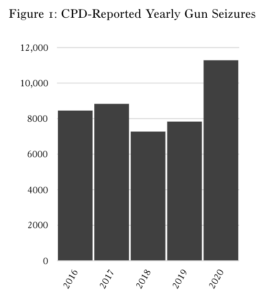
Next, an examination of traffic and pedestrian stops reveals divergent patterns. On the one hand, pedestrian stops were low in 2016 in the wake of protests over the shooting death of Laquan MacDonald, but had been slowly climbing until 2020 — when they sharply declined (by about a third). In contrast, the volume of traffic stops had been increasing steadily until 2020, when the volume of such stops plummeted by almost fifty percent due to the pandemic. At least with respect to gun violence, one implication of Figures 1 and 2 in tandem is that up to 2019, a high volume of involuntary police-citizen contacts had not been generating a correspondingly high volume of weapon seizures. To the extent that stops were meant to mitigate violent crime by removing guns from circulation, therefore, they were an inefficient use of coercion.
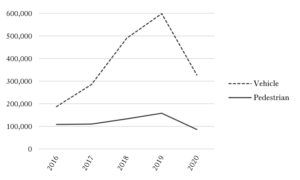
How could police have seized more guns at a time when both pedestrian and traffic stops drastically declined? A partial explanation emerges when looking at the percentage of stops that result in a search. Under Terry v. Ohio,90 a police officer is entitled to make a “brief” nonconsensual “investigatory stop” if she has “reasonable, articulable suspicion” that a crime either has occurred or is about to occur.91 Reasonable, articulable suspicion is a less demanding standard than probable cause, but still requires “a minimal level of objective justification.”92 If the officer also has a further reasonable articulable suspicion that the person stopped is “armed and presently dangerous to the officer or to others,” she may also conduct a “limited protective search” for weapons.93 Hence, a stop may or may not be accompanied by a frisk — not least because separate legal justifications are required for each action.
Figures 3a and 3b display the changing proportion of pedestrian stops that have been accompanied by frisks. Between 2018 and 2020, that proportion increased by about fifty percent. This implies that, in 2020, either (1) officers used their discretion to conduct more Terry frisks, or (2) the stopped population appeared more suspicious to officers who continued to apply the same threshold of suspicion. It is not possible to distinguish between these explanations based on available data. Nevertheless, it is plausible to read this change in police behavior as reflecting Superintendent Brown’s strategy to seize more guns to reduce violent crime. Indeed, consistent with these patterns, Cook County State’s Attorney Kim Foxx, has identified a “steady increase in Chicago police arrests of people who have no prior convictions but are caught illegally carrying a gun.”94
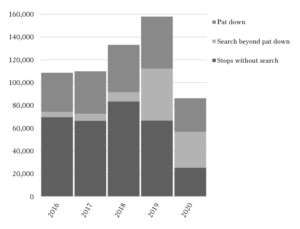
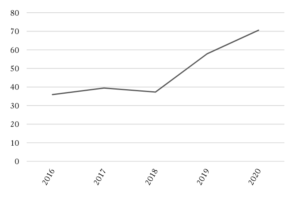
Figure 4 breaks down stop-and-frisk data for pedestrian stops and vehicle stops by race and ethnicity. The shifting pattern of new stops has a racial footprint. As this Figure shows, even as the overall number of stops fell, the burden of increased stop and frisks fell on Black and Hispanic people. These encounters inflict both short-term and long-term harms, particularly on minority subjects,95 including “stigma,” “trauma,” and “anxiety.”96 It is difficult to see why this shift would have been elicited by the pandemic alone.
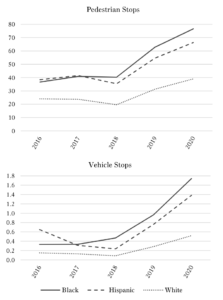
Chicago’s increased focus on enforcing gun possession crimes led to a greater concentration of costs on minority citizens, even at a time when the overall volume of police coercion had declined due to the pandemic. Simultaneously, the Black and Latino neighborhoods identified for more investment and security in the Mayor’s Comprehensive Plan experienced sharp rises in crime: West Pullman had 566% more fatal shootings; North Lawndale had 201% more; and South Lawndale had 160% more.97 Further, while CPD’s street stops and arrests of those with no prior convictions have sharply risen, the rate of arrests for violent gun crimes has “trended down.”98 Although the possibility that racially concentrating stops produced more security cannot be ruled out, there is very little reason to believe that policing had a suppressive effect on shootings given the magnitude of these increases. Instead, it seems more plausible that policing aimed at suppressing gun crime increased the burden of policing for minority communities without any corresponding alleviation of violent crime risk.
In sum, the effects of policing focused on gun possession can be interpreted as a problematic form of disparate racial impact “by which historical patterns of disadvantage are maintained, transmitted forward in time, and perhaps exacerbated.”99 The Chicago response to the 2020 crisis of policing exacerbated the cost of public safety for racial minorities, likely without any corresponding benefit.
Conclusion
This Essay highlights how Chicago police used gun control rhetoric to simultaneously weather unprecedented protest and increase the disparate impact of policing on Black and Latino communities. Specifically, this was accomplished by framing the problem in terms of gun violence, offering both regulatory and coercive proposals, and then pursuing only the latter — to the detriment, paradoxically, of the minority communities most directly affected by gun violence. To be sure, this does not fully explain the 2021 budgetary jump in police support — but the decision to pump more dollars into the CPD becomes more legible given the dynamics described here.
We should not be read as suggesting that our account exhausts the potential range of regressive political vectors, or even as offering a broad claim about the success or failure of BLM in Chicago or elsewhere. We’ve been asked to write about the role that gun talk plays, and this Essay faithfully hews to the limits of its mandate. Nevertheless, we hope to stimulate a conversation here about a topic that recent work romanticizing social movements has wholly missed: the powerful resources and strategies that the police state can mobilize when threatened. It is only by comprehending the complex dynamic of counter-mobilization that we begin to grasp the nettlesome obduracy of the deep historical injustices embedded in our political and policy arrangements.
* Frank and Bernice J. Greenberg Professor of Law, University of Chicago Law School.
** Associate Professor of Sociology, University of Chicago.
*** Research Associate, University of Chicago. Some of the authors participated in protests discussed in this Essay. To the best of our knowledge, we believe that this has not influenced our analysis.